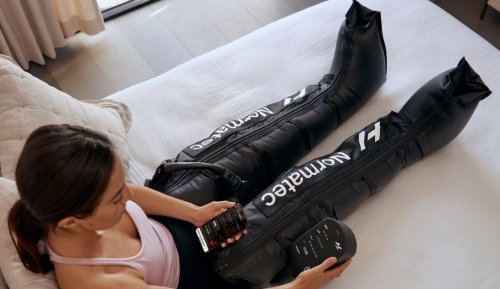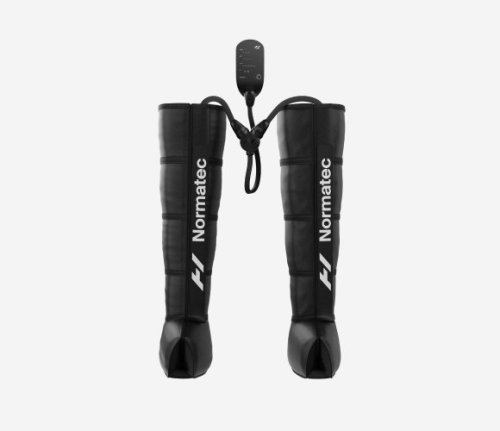Our editors independently select these products. Making a purchase through our links may earn Well+Good a commission
My Husband and I Fight Over These Recovery Compression Boots After Our Workouts
Our Normatec 3 Review of this compression boots system dives into why they feel so good, and asks whether they're worth the money.

My husband and I have just finished a HIIT workout, and once we catch our breath, there is going to be a mad dash. Whoever can get up off the floor fastest snags a delicious, restorative, 30-minute session in Hyperice’s Normatec 3 Legs first. What the heck does that mean? The Normatec 3s are pneumatic compression boots, the latest version of the Normatec Leg Recovery System. They are basically individual pant legs that hook up to a pump, inflate, and squeeze different portions of your legs—from your hips to your feet—throughout sessions that last 15, 30, 45, or 60 minutes.
Experts in This Article
exercise physiologist and certified personal trainer
The idea is that NormaTec’s patented rhythmic series of massage, compression, and deflation will help you recover faster by encouraging de-oxygenated blood and other fluid buildup (like lactic acid) to leave your legs, in order to make room for new blood flow. It also happens to feel amazing.

Normatec 3 Legs — $799.00
If you’re willing to spend big bucks on feeling amazing, these compression boots deliver the “aaaahhhhs.”
Why does encasing your legs in pulsating vinyl air tubes feel great, though?
I’ve spent a lot of time thinking about this. Yes, there’s the massage aspect of it: I have moaned audibly, in particular, when the boots squeeze around my hips where I carry so much tension. Meanwhile my husband relishes the rush of new blood flow he feels when the top of the boots decompress, like he’s getting an infusion of energy back into his tired legs.
“Since pneumatic boots combine aspects of massage and compression, it makes sense that they would feel good and make someone feel like they were reducing soreness,” says exercise physiologist Sharon Gam, PhD, CSCS. That’s because research shows that massage and compression rate as the two most-effective modalities when it comes to reducing perceptions of delayed onset muscle soreness (DOMS), says Dr. Gam.
But I’ve realized that what I really love about them is the fact that the boots make my whole bottom half feel weightless. Even when I’m lying on the couch after a workout, I still feel like my legs are heavy and like I am still responsible for their existence. Dr. Gam says that’s thanks to all the small stabilizer muscles that are still working even when you’re lying down. But the air support of the boots relieves those muscles of their duties.
“You don’t just completely turn into Jell-O when you lie down, right?” explains Dr. Gam. “And so the boots are probably just giving you a little bit of structure and support to allow even those tiny, tiny little muscles—or the very, very small amount that your major muscles have to stay active—to let go of that. And you perceive that as this weightlessness, or this relief, and that sounds really nice.”
How compression boots became a recovery tool
Normatec boots are an example of necessity being the mother of invention. The technology was invented by Laura Jacobs, MD, a physician (who happens to be the actual mother of Normatec Recovery founder Gilad Jacobs) after she realized there was no effective treatment for breast cancer patients experiencing liquid pooling in their arms due to surgeries causing backup in their lymphatic systems. (Pneumatic compression means compressing the lymphatic system.)
Cancer doctors were dismissive of the women’s complaints, and the only option for patients was to wrap their arms in ACE bandages and pin them up at night to help with drainage. So Dr. Jacobs, who was a rehab specialist that also had a degree in bioengineering (NBD), decided to manufacture a device of her own. That’s how Normatec’s patented “Norma Massage” protocol (named for Dr. Jacobs’ mother Norma) came into being.
Several years later, Dr. Jacobs’ son wondered whether there might be an application for athletes, including those who were experiencing swelling due to inflammation and injury. The devices—which cost nearly $5,000 at the time—flew off the shelves, and Jacobs learned through the professional and college athletics programs he sold them to that non-injured athletes were using the compression boots as well for general recovery. That’s how Normatec came up with their marketing slogan of “Fresher legs faster”— because it was what the athletes were telling them was happening. “By mimicking what the body does naturally, we’re speeding up the [recovery] process in a way that also feels really good,” Jacobs says.
Today, you can find them in the recovery centers of pro-athletes all over the world, as well as in people’s living rooms.
What the science says about compression boots and fitness recovery
We’ve already established that they feel really freaking great. But when deciding whether they’re worth the money, Dr. Gam warns to be wary of some of the marketing claims: A meta-analysis of studies on compression boots’ effect on performance found little evidence that this sort of tech improves performance. When it comes to muscle soreness, Dr. Gam notes that usually, measures of reducing DOMS are subjective and could even be due to the placebo effect.
“If you feel like you can push a little bit harder and you’re recovered better—and that helps you to give your all in the next session or to not skip a session because you feel like you’re too sore—yeah, I think that’s definitely worthwhile,” Dr. Gam says. “But I think that if you try to then take that and connect it to whether or not your body has recovered better, that connection is not really clear.”
The keys to true recovery are time, sleep, and healthy nutrition. Dr. Gam says the boots are no replacement for those fundamentals, and that if athletes are using them, it’s as a cherry on top of an already personally optimized recovery routine. Since not everyone works out to the extent that they may feel the need for high-tech recovery, and because of the price tag, Jacobs acknowledges that the boots may not be for everyone. However he notes that this is the most accessible version of the boots yet: The NormaTec 3s cost hundreds of dollars less than their predecessors, and come with a retooled control unit that is super easy and intuitive to use.
But he also thinks that people are making recovery a bigger part of their lives—and, as a result, they’re willing to invest in tools geared toward helping them optimize the experience. “We’re so proactive about our workouts, about our nutrition,” he says. “We should also be really proactive toward our recovery.” If that means a 30-minute session in these boots, that’s a (reclined) position I’m willing to consider.
Sign up for the Well+Good SHOP Newsletter
Get exclusive deals on wellness, beauty, fitness, and food products that have been hand-picked by our editors.
Got it, you've been added to our email list.







